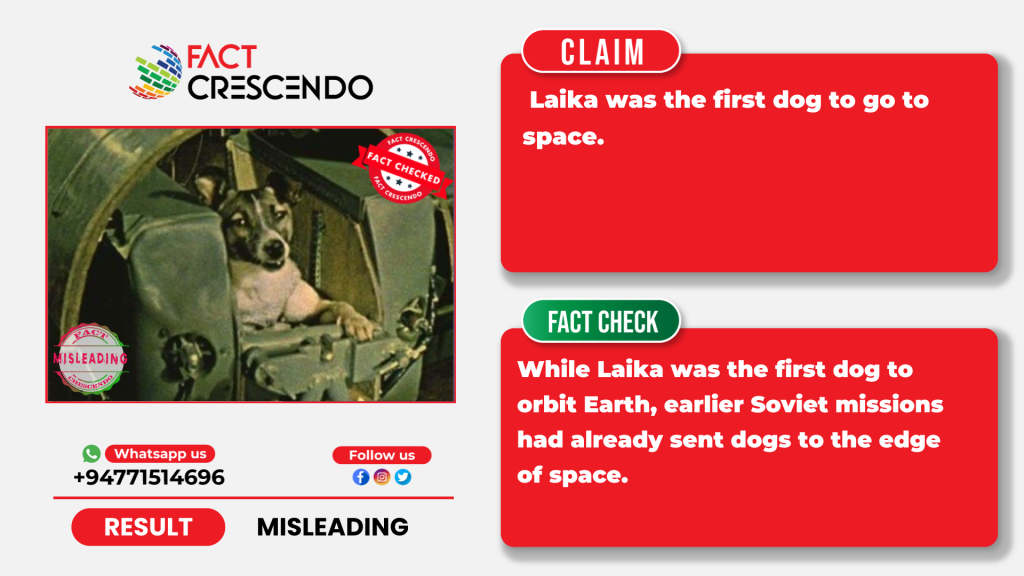
November 3, 1957, is an important date in the calendar of history because Laika, Russia’s mongrel dog, set off into space on Sputnik 2. Laika, one of the strong symbols in the early years of the space race, is remembered as a token of man’s determination to set out into the cosmos. A stray from Moscow, Laika had been selected for this very first mission. While she is commonly hailed as the first animal in orbit around Earth, her launch into space also introduced the world to ethical debates regarding the use of animals in space travel. However, was Laika really the first dog launched into space? We shall examine this assertion in its historical context and clarify some common misconceptions.
Social Media Posts
Recently, a large number of users shared the story of Laika to commemorate the dog’s sacrifice, together with claims that this was “the first dog to travel to space.”
One of the popularly held claims regarding space history is that Laika was the very first dog into space. While the voyage of Laika aboard Sputnik 2 is widely regarded as a groundbreaker, there has been some confusion regarding whether she was actually the first dog launched beyond Earth.
Fact-check
Soviet Canine Cosmonauts Before Laika
Before the record flight of Laika in 1957, Soviet scientists had already tested canine flights on the effects of high-altitude and near-space flights on living organisms.
Throughout 1951 into the mid-1950s, the Soviet Union launched several dogs on suborbital flights using such rockets as the R-1 and R-2 series to altitudes near the edge of space at approximately 100 kilometers above sea level. These precursor missions were groundbreaking tests, returning information about life-support systems, spacecraft design, and biological responses to conditions near space.
Notable canine passengers before Laika include:
- Dezik and Tsygan: Launched in 1951, Dezik and Tsygan were among the first dogs to travel to the edge of space on a suborbital flight. The flight was brief and did not attain orbit but established that dogs could survive under extreme conditions. The dogs appeared to return safely to Earth.
- Lisa and Ryzhik: These animals flew similar missions, each continuing the Soviet testing and development of re-entry technology.
Laika’s Orbiting Mission
Laika’s flight on Sputnik 2 was the first orbital flight by a living creature, making her the first orbital space traveler among animals. She was on a one-way journey since there was no reentry technology for Sputnik 2, and this made her flight both pioneering and very contentious. Laika suffered much physical stress and overheating; she died after a few hours. Her contribution to science, though at a high price, allowed the way for human space exploration.
Defining ‘First Dog in Space’
If “first dog in space” means no more than crossing the boundary of space, then the first will be Dezik and Tsygan in 1951. However, Laika was the very first dog to orbit Earth, as well as the first living creature to do so; therefore, she should be regarded as the world’s first orbital space traveler. That’s because of a very simple reason: in the vernacular of spaceflight, a suborbital mission—as opposed to an orbital one—involves far less velocity, where the spacecraft briefly enters the edge of space and returns rather than circling Earth.
Context: Why Dogs Were Chosen for Early Space Missions
Dogs became the target for the early space research due to their very friendly nature, the ease with which they could be trained, and the experience developed by Soviet scientists in training dogs for all kinds of tasks. Stray dogs were preferred in these missions because it was believed that they were stronger and more resilient by Soviet scientists. They chose dogs according to physical parameters—mostly pertaining to small size—and behavior so that the future space travelers would not present problems in the small capsules and during tiring training.
Concerned first with the flights at high altitudes and at increased speeds, testing survival but also the potential effects of space conditions, the Soviet program generated data that proved to be highly valuable and helped in conducting successful human spaceflights later. Laika’s mission brought in critical information on living conditions that might pose a threat or be an issue for the humankind space travelers; thus, it contributed to the design and life support systems used in further missions.
Summary
Less briefly, Laika was the very first dog orbiting Earth’s field but not the first one to reach space. Dezik and Tsygan, along with other dogs, formed the previous suborbital flights of the Soviet Union, touching the edge of space years before Laika’s flight. Nonetheless, the flight of Laika aboard Sputnik 2 remains historically important as the first orbital flight of a living creature. This difference in fortune set the scene for the following manned space flights, but would come with a tremendous ethical cost.
Laika’s story remains alive to this date and signifies probably most of the victories and moral dilemmas of the early space race. While her legacy lives as the very first orbital astronaut in the animal world, it is important to bear in mind that before her, many other dogs also traced their paths towards human space travel.

Title:Laika is not the first dog in space,but the first to orbit earth
Written By: Fact Crescendo TeamResult: Misleading





